
In August 2021, ukactive launched Digital Futures in partnership with Sport England and in collaboration with the leisure sector. The Digital Futures Advisory Group set out to improve the application of digital within leisure, to enhance consumer experiences and drive value to operators.
Digital Futures has been designed to support the fitness and leisure sector, measure its digital maturity and effectiveness, and provide a reference point to build out a clear path of further understanding to meet the needs and demands of the consumer.
This report will support operators in the enhancement or design of their own digital transformation journeys, as well as identifying the challenges and opportunities for digital adoption.
The 2022 consultation process was well supported, with more than double the number of participants compared to 2021.
46% say that digital will play a central or critical role in their future compared to 34% in 2021
Encouraging findings highlight the benefits that a large number of operators have already found by engaging in the Digital Futures programme. Using the online tool to assess their current maturity and effectiveness, and working across their departments and with suppliers, many have formed digital strategies that have set them on the right course to maximise their digital experiences and deliver the insights they need to inform operational and commercial decisions. This digital maturity and effectiveness online tool is available via the link on our report.
ukactive acknowledges that digital solutions in isolation are not the answer, nor is digital transformation about replacing human interactions with digital – something that’s particularly important to understand in the human-centred, community-based, expert-supported fitness and leisure sector.
Digital transformation is about creating a unifying web that connects both digital and human interactions. In a recent ukactive Digital Futures paper, we defined connected fitness as:
‘The symbiotic connection of front- and back-end systems, using data to inform business decisions that meet commercial objectives and consumer expectations, while improving wellbeing’